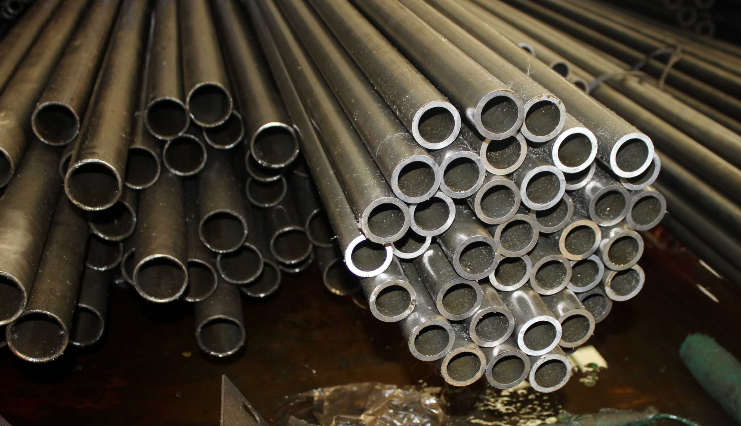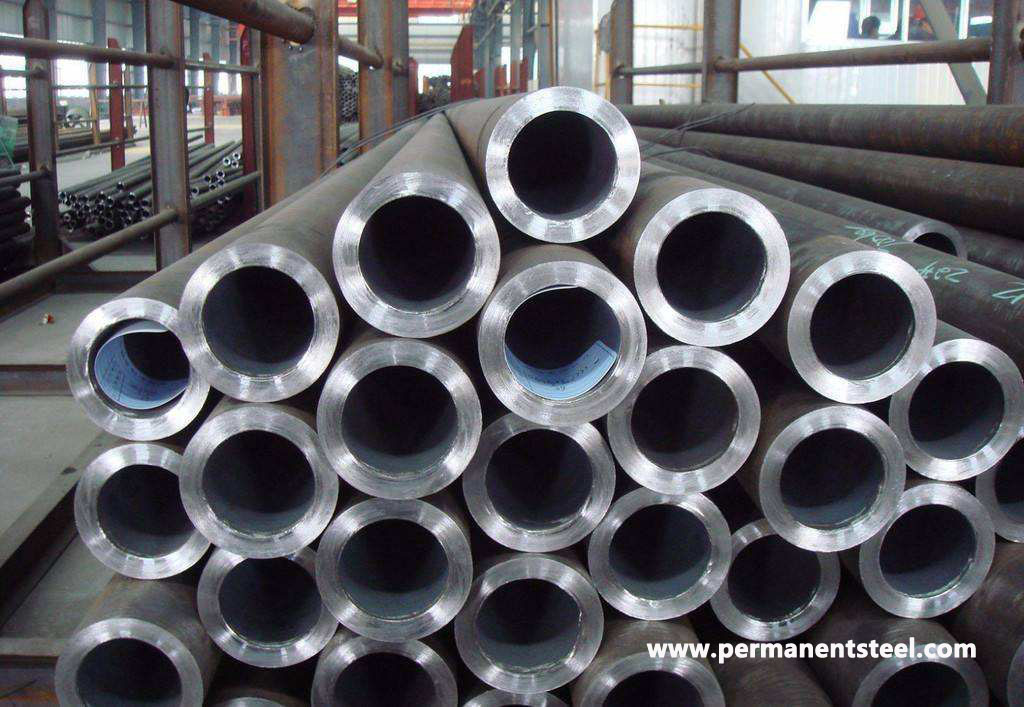
Differences between Hot Rolled and Cold Rolled Seamless Steel Tube
Cold-rolled seamless steel pipes are often of small diameter, and hot-rolled seamless steel pipes are often of large diameter. The accuracy of cold-rolled seamless steel pipe is higher than that of hot-rolled seamless steel pipe, and the price is also higher than that of hot-rolled seamless steel pipe.
Seamless steel pipes are divided into hot-rolled (extruded) seamless steel pipes and cold-drawn (rolled) seamless steel pipes due to their different manufacturing processes. Cold drawn (rolled) tubes are divided into round tubes and special-shaped tubes.

1) Different uses
There are differences in the uses of hot-rolled seamless pipes and cold-rolled seamless pipes. Because the manufacturing process of hot-rolled seamless steel pipes is relatively simple and its price is relatively low, it is widely used in construction, machinery manufacturing and other fields. Cold-rolled seamless steel pipes are widely used in petrochemical, pressure vessels, machinery manufacturing and other fields due to their high strength, high hardness, corrosion resistance and other excellent properties.
Hot-rolled seamless pipes are divided into general steel pipes, low and medium pressure boiler steel pipes, high pressure boiler steel pipes, alloy steel pipes, stainless steel pipes, petroleum cracking pipes, geological steel pipes and other steel pipes. Cold-rolled (drawn) seamless steel pipes are divided into general steel pipes, low and medium pressure boiler steel pipes, high pressure boiler steel pipes, alloy steel pipes, stainless steel pipes, petroleum cracking pipes, and other steel pipes, as well as carbon thin-walled steel pipes, alloy thin-walled steel pipes, Stainless thin-walled steel pipes, special-shaped steel pipes.
2) Different sizes
The outer diameter of hot-rolled seamless pipe is generally greater than 32mm and the wall thickness is 2.5-75mm. The diameter of cold-rolled seamless pipe can be up to 6mm and the wall thickness can be up to 0.25mm. The outer diameter of thin-walled pipe can be up to 5mm and the wall thickness is less than 0.25mm. Cold rolling has higher dimensional accuracy than hot rolling.
3) Different dimensional accuracy
Due to different manufacturing processes, there are also differences in the dimensional accuracy of hot-rolled seamless pipes and cold-rolled seamless steel pipes. The dimensional accuracy of hot-rolled seamless pipes is low, the pipe wall thickness is uneven, and the deviations in pipe diameter and wall thickness are large. The cold-rolled seamless steel pipe has higher dimensional accuracy, uniform pipe wall thickness, and smaller deviations in pipe diameter and wall thickness. Therefore, cold-rolled seamless steel pipes are usually used where high-precision dimensions are required, such as in petrochemical, pressure vessel and other industries.
4) Different manufacturing processes
Hot-rolled seamless pipes are heated to high temperatures and then rolled, and are made through multiple processes such as perforation, pipe rolling, cutting, and cooling. Cold-rolled seamless steel pipes are rolled through cold rolling mills and made through multiple processes such as pickling, phosphating, saponification, and lubrication. Therefore, hot-rolled seamless steel pipes have coarser grains and have a certain toughness, while cold-rolled seamless steel pipes have finer grains and have higher strength and hardness.
5) Different mechanical properties
There are also differences in the mechanical properties of hot-rolled seamless steel pipes and cold-rolled seamless pipes. Since the manufacturing process of hot-rolled seamless steel pipes is relatively simple, its tensile strength and yield point are relatively low, while cold-rolled seamless steel pipes have higher tensile strength and yield points due to multiple processes. In addition, hot-rolled seamless steel pipes have better impact toughness, while cold-rolled seamless steel pipes have poor impact toughness. Therefore, cold-rolled seamless steel pipes are usually used where high strength and hardness are required, such as machinery manufacturing, building structures and other industries.
6) Different corrosion resistance properties
There are also differences in the corrosion resistance of hot-rolled seamless pipes and cold-rolled seamless pipes. Due to the presence of defects and oxide layers on the surface of hot-rolled seamless steel pipes, their corrosion resistance is relatively poor. Cold-rolled seamless steel pipes have been processed through multiple processes, resulting in higher surface smoothness and better corrosion resistance. Therefore, cold-rolled seamless steel pipes are usually used where corrosion resistance is required, such as in chemical, petroleum and other industries.
7) Difference in process
1. The cold-rolled formed steel allows local buckling of the section, which can make full use of the bearing capacity of the bar after buckling; while the hot-rolled steel does not allow local buckling of the section.
2. Hot-rolled steel and cold-rolled steel have different causes of residual stress, so the distribution on the section is also very different. The residual stress distribution on the cross-section of cold-formed thin-walled steel is curved, while the residual stress distribution on the cross-section of hot: rolled steel or welded steel is thin-film.
3. The free torsional stiffness of hot-rolled steel is higher than that of cold-rolled steel, so the torsion resistance of hot-rolled steel is better than that of cold-rolled steel.
8) Different advantages and disadvantages
Cold-rolled seamless steel tubes refers to a steel plate or steel strip processed into various types of steel by cold drawing, cold bending, cold drawing and other cold processing at room temperature.
Fast forming speed, high output, and without damage the coating, can be made into a variety of cross-sectional forms to meet the needs of use conditions; cold rolling can cause large plastic deformation of steel, thereby improving the yield of steel point.
Disadvantages:
1. Although there is no thermal plastic compression during the forming process, there are still residual stresses in the section, which will inevitably affect the overall and local buckling characteristics of the steel;
2. The style of cold-rolled steel is generally an open section, which makes the free torsional stiffness of the section lower. It is prone to torsion when being bent, and it is prone to bending and torsion buckling when being compressed, and the torsion resistance is poor;
3. The wall thickness of cold-rolled steel is small, and there is no thickening at the corners where the plates join, and the ability to withstand local concentrated loads is weak.

Hot-rolled seamless steel tubes are relative to cold-rolled seamless tubes. Cold-rolled seamless tubes are rolled below the recrystallization temperature, while hot-rolled seamless tubes are rolled above the recrystallization temperature.
Advantages:
It can destroy the casting structure of the steel ingot, refine the grain of the steel, and eliminate the defects of the microstructure, so that the steel structure is dense and the mechanical properties are improved. This improvement is mainly reflected in the rolling direction, so that the steel is no longer isotropic to a certain extent; bubbles, cracks and looseness formed during casting can also be welded under high temperature and pressure.
Disadvantages:
1. After hot rolling, the non-metallic inclusions (mainly sulfides and oxides, as well as silicates) inside the steel are pressed into thin sheets, and delamination (interlayer) occurs. Delamination greatly deteriorates the tensile properties of the steel in the thickness direction, and it is possible that interlayer tearing may occur when the weld shrinks. The local strain induced by weld shrinkage often reaches several times the yield point strain, which is much larger than the strain caused by the load;
2. Residual stress caused by uneven cooling. Residual stress is the internal self-balanced stress without external force. Hot-rolled steel sections of various cross-sections have such residual stresses. Generally, the larger the section size of the steel section, the larger the residual stress. Although the residual stress is self-balanced, it still has a certain influence on the performance of steel components under external force. For example, it may have adverse effects on deformation, stability, and fatigue resistance.
3. Hot-rolled steel products are not easy to control in terms of thickness and edge width. We are familiar with thermal expansion and contraction. Because at the beginning, even if the length and thickness are up to the standard, there will be a certain negative difference after the final cooling. The wider the negative difference, the thicker the thickness, the more obvious the performance. Therefore, for large steel, the side width, thickness, length, angle, and sideline of the steel cannot be too precise.
Generally seamless steel pipes are made of 10, 20, 30, 35, 45 and other high-quality carbon steels such as 16Mn, 5MnV and other low-alloy structural steels or 40Cr, 30CrMnSi, 45Mn2, 40MnB and other alloy steels by hot rolling or cold rolling. Seamless pipes made of low carbon steel such as 10 and 20 are mainly used for fluid transportation pipelines. Seamless tubes made of medium carbon steel such as 45 and 40Cr are used to manufacture mechanical parts, such as stressed parts of automobiles and tractors. Generally, seamless steel pipes must be used for strength and flattening tests. Hot-rolled steel pipes are delivered in hot-rolled state or heat-treated state; cold-rolled steel pipes are delivered in heat-treated state.
Tips: ASTM A53 vs. ASTM A106: The ASTM A53 standard includes welded pipes and seamless steel pipes, and ASTM A106 is only seamless steel pipes.


